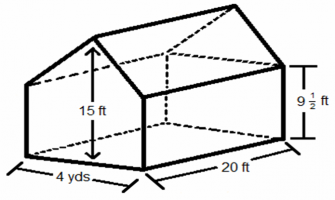eddy2017
Elite Member
- Joined
- Oct 27, 2017
- Messages
- 2,525
A building contractor needs to compute the volume of air contained in a building with a rectangular floor, as shown in the figure below. The building is 20 feet long, 4 yards wide, 9 12 feet high on two sides 9 and a half feet high on two sides and 15 feet high from the floor to the peak. What is the volume of air in the building in cubic feet?

the great FIND = Volume of air in the building in cubic ft.
measurements of the building thaat have been given
l =20 ft
w=4 yards ( I am converting to a single unit so 1f=3yds = 4* 3= 12 ft)
height on the sides=9 1/2 ft
height from the floor to the top of the ceiling =15 ft
The formula for volume applies here
[math]V = l * w * h[/math]
I have two heights so that is what got me stuck, any hints?
thanks,

the great FIND = Volume of air in the building in cubic ft.
measurements of the building thaat have been given
l =20 ft
w=4 yards ( I am converting to a single unit so 1f=3yds = 4* 3= 12 ft)
height on the sides=9 1/2 ft
height from the floor to the top of the ceiling =15 ft
The formula for volume applies here
[math]V = l * w * h[/math]
I have two heights so that is what got me stuck, any hints?
thanks,
